The ASRock DeskMini A300 Review: An Affordable DIY AMD Ryzen mini-PC
by Ganesh T S on April 26, 2019 8:00 AM ESTGPU Performance - Gaming Workloads
Our revamped gaming test suite for 2018 involves six different games:
- Civlization VI (DX12)
- Dota 2
- F1 2017
- Grand Theft Auto V
- Middle Earth: Shadow of War
- Far Cry 5
Most system reviews take a handful of games and process them at one resolution / quality settings for comparison purposes. Recently, we have seen many pre-built systems coming out with varying gaming capabilities. Hence, it has become imperative to give consumers an idea of how a given system performs over a range of resolutions and quality settings for each game. With our latest suite, we are able to address this aspect.
Civilization VI (DX12)
The Civilization series of turn-based strategy games is very popular. For such games, the frame rate is not necessarily an important factor in the gaming experience. However, with Civilization VI, Firaxis has cranked up the visual fidelity to make the game more attractive. As a result, the game can be taxing on the GPU as well as the CPU, particularly in the DirectX 12 mode.
| Civilization VI (DirectX 12) Performance | |||
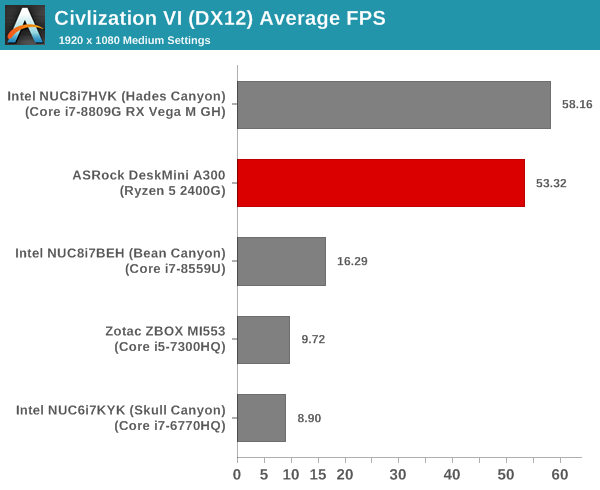
We processed the built-in benchmark at two different resolutions (1080p and 2160p), and with two different quality settings (medium and ultra, with the exact differences detailed here). At both resolutions and quality settings, we find the DeskMini A300 with a significant lead over other systems with integrated GPUs.
Dota 2
Dota 2 has been featuring in our mini-PC and notebook reviews for a few years now, but, it still continues to be a very relevant game. Our evaluation was limited to a custom replay file at 1080p resolution with enthusiast settings ('best-looking' preset). We have now revamped our testing to include multiple resolutions - This brings out the fact that the game is CPU-limited in many configurations.
Dota 2 allows for multiple renderers - we use the DirectX 11 mode. The rendering settings are set to 'enthusiast level' (best-looking, which has all options turned on, and at Ultra level, except for the Shadow Quality set to 'High'). We cycle through different resolutions after setting the monitor resolution to match the desired resolution. The core scripts and replay files are sourced from Jonathan Liebig's original Dota 2 benchmarking instructions which used a sequence of frames from Match 3061101068.
| Dota 2 - Enthusiast Quality Performance | |||
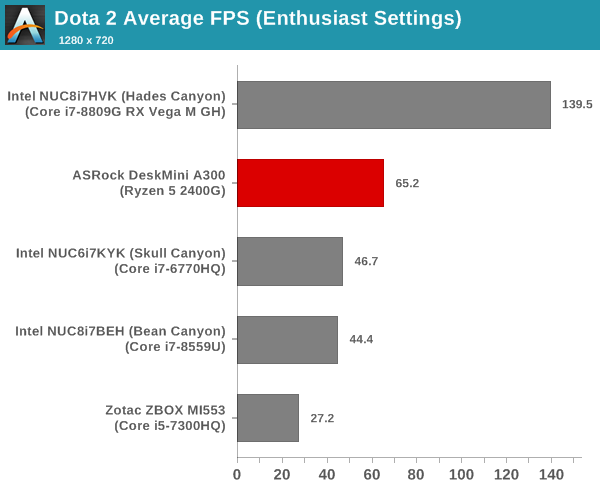
CPU-limited, or not, the same results of the DeskMini A300 being the best integrated GPU-system of the lot holds true for Dota 2 also.
F1 2017
Our gaming system reviews have always had a representative racing game in it. While our previous benchmark suite for PCs featured Dirt 2, we have moved on to the more recent F1 2017 from Codemasters for our revamp.
| F1 2017 - Ultra Quality Performance | |||
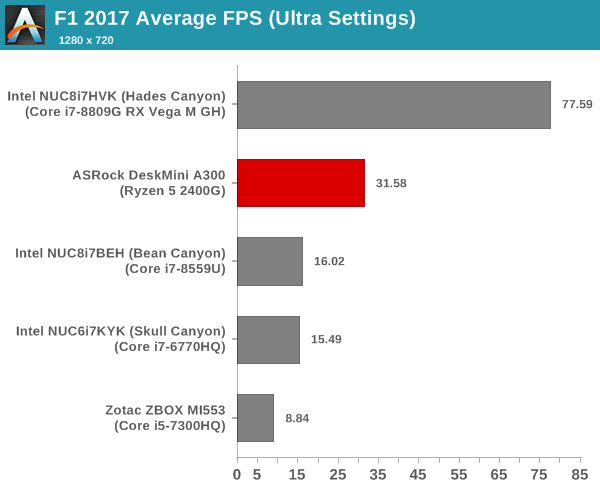
The supplied example benchmark (with some minor tweaks) is processed at four different resolutions while maintaining the graphics settings at the built-in 'Ultra' level. We don't see any surprises in this game's benchmarks.
Grand Theft Auto V
GTA doesn’t provide graphical presets, but opens up the options to users and extends the boundaries by pushing even the hardest systems to the limit using Rockstar’s Advanced Game Engine under DirectX 11. Whether the user is flying high in the mountains with long draw distances or dealing with assorted trash in the city, when cranked up to maximum it creates stunning visuals but hard work for both the CPU and the GPU. For our test we have scripted a version of the in-game benchmark. The in-game benchmark consists of five scenarios: four short panning shots with varying lighting and weather effects, and a fifth action sequence that lasts around 90 seconds. We use only the final part of the benchmark, which combines a flight scene in a jet followed by an inner city drive-by through several intersections followed by ramming a tanker that explodes, causing other cars to explode as well. This is a mix of distance rendering followed by a detailed near-rendering action sequence.
| Grand Theft Auto V Performance | |||
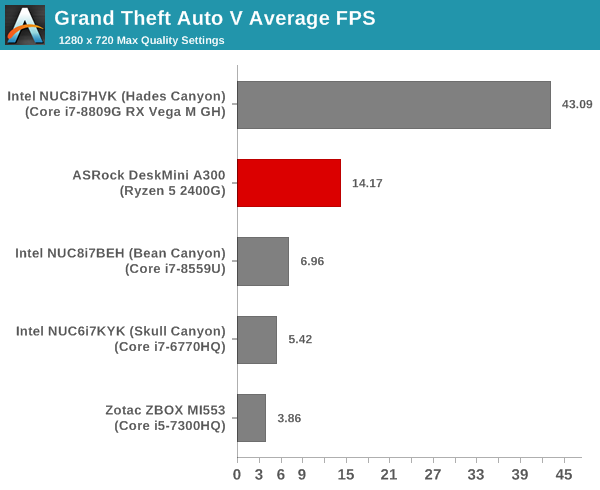
We processed the benchmark across various resolutions and quality settings (detailed here). The results are presented above. At the risk of sounding like a broken record, the DeskMini A300 again turns out to be the best iGPU-only system in our list.
Middle Earth: Shadow of War
Middle Earth: Shadow of War is an action RPG. In our previous gaming benchmarks suite, we used its prequel - Shadow of Mordor. Produced by Monolith and using the new LithTech Firebird engine and numerous detail add-ons, Shadow of War goes for detail and complexity. The graphics settings include standard options such as Graphical Quality, Lighting, Mesh, Motion Blur, Shadow Quality, Textures, Vegetation Range, Depth of Field, Transparency and Tessellation. There are standard presets as well. The game also includes a 'Dynamic Resolution' option that automatically alters graphics quality to hit a pre-set frame rate. We benchmarked the game at four different resolutions - 4K, 1440p, 1080p, and 720p. Two standard presets - Ultra and Medium - were used at each resolution after turning off the dynamic resolution option.
| Middle Earth: Shadow of War Performance | |||
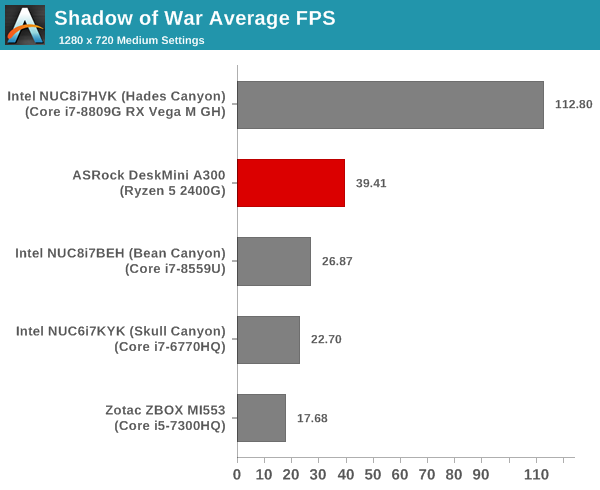
The relative numbers are no different from what was observed in the other games.
Far Cry 5
Ubisoft's Far Cry 5 is an action-adventure first-person shooter game released in March 2018. The game comes with an in-built benchmark and has standard pre-sets for quality settings. We benchmarked the game at four different resolutions - 720p, 1080p, 1440p, and 2160p. Two preset quality settings were processed at each resolution - normal and ultra.
| Far Cry 5 Performance | |||
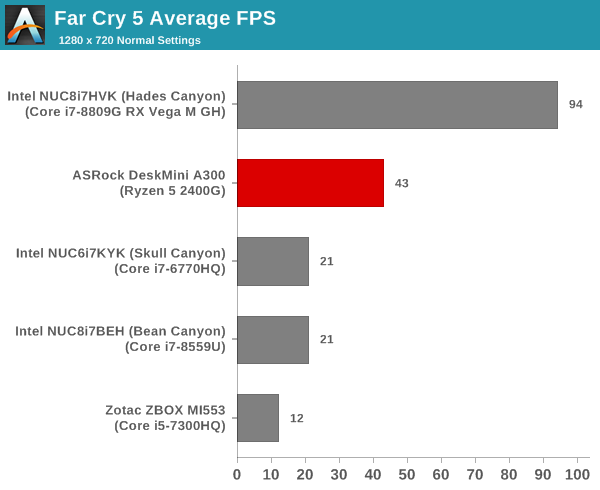
Overall, the DeskMini A300 with the Ryzen 5 2400G emerges as a clear-cut winner for folks looking to game without a discrete GPU. Even the best iGPU that Intel can offer in the Iris Plus series is unable to approach the Vega 11 GPU integrated into the Ryzen processor.










88 Comments
View All Comments
Haawser - Sunday, April 28, 2019 - link
@oliwek That's the 310, it's an Intel barebones system, not Ryzen.sor - Saturday, April 27, 2019 - link
If you sign up for Newegg notifications you’ll probably have one within a week. I got one of mine about three weeks ago and the other last week.yankeeDDL - Monday, April 29, 2019 - link
I'm just going to throw it as a suggestion.I understand the purpose and the rationale in comparing similarly priced models, and all relatively recent/available, however ... I think it would add an enormous value to "normal" users to be able to somewhat put things in perspective with slightly dated hardware.
I am not saying that we should be able to compare the Ryzen 5 2400G with an 80486, but, to give you an example, I have an A10-8700P and I have been considering an upgrade, but it seems really difficult to find a way to get an idea of just how much faster the 2400G is.
The A10-8700P is certainly not efficient, but it does have 4 cores, and a decent iGPU, already based on the GCN. There's no question that the 2400G will trounce it in efficiency, but is it a worth upgrade?
It is just an example, to indicate that having also 2-3 previous generations in the comparisons would not be such a bad idea, in my opinion. Just a thought.
Irata - Wednesday, May 1, 2019 - link
If you are looking for this type of comparison, planet3dnow de has one between an Athlon 5350 (Jaguar) vs Athlon 200GE. It's in German but maybe you can get useable results using Google translate.They also did a review of the Hewlett-Packard 17-ca1004ng notebook with a Ryzen 5 3500U comparing it to its Bristol Ridge predecessor.
Both show just how far AMD has come with Ryzen.
mikato - Tuesday, April 30, 2019 - link
Ganesh, you didn't talk about noise at all. I feel like that should always be included in these mini PC articles. You have 3 pages on HTPC credentials and 1 page on Power Consumption and Thermal Performance but no mention of noise. How does it compare to the Intel NUC8i7BEH that you mentioned had a noisy fan with any load? Or the ZBOX CI660 which was fanless but had a dull whine and a strange grating sound though it wasn't noticeable beyond 10 feet? Did you think that optional CPU heatsink/fan they included was adequate?By the way, 10 feet isn't close enough. How about 6 feet? If you give one noise impression from 10 feet, you could move a few feet closer and check what it is at 6 feet as well... for future reviews.
If you keep doing these Mini PC reviews, I will keep reading them!
Lucky Stripes 99 - Sunday, May 5, 2019 - link
I was also puzzled at the lack noise testing. One of the reasons I'm looking at mini-STX and thin mini-ITX systems instead of a NUC is because of the fan noise many of those NUC systems suffer from.Some folks have been installing low-profile Noctua CPU coolers in their Deskmini systems and they report that they are "nearly silent", even while under heavy load. I'd really like to know how silent that really is.
werpu - Monday, May 6, 2019 - link
I have a ryzen 2400g mini itx system with the flat noctua, and it is very silent, even under heavy load it is almost not hearable. I however had to add 2 smaller noctuas later in my system because the vrm would get rather hot with my standalone noctua and the case I was using. Still a very silent system and definitely less noise than a nuc.mikato - Tuesday, April 30, 2019 - link
At first I thought Bean Canyon was the best way to go for an HTPC with the performance and power efficiency. But with an idle power usage of 11.24 watts for this DeckMini A300 vs the 8.45 watts of the NUC8i7BEH with Bean Canyon - that difference is so little. As my HTPC, it would be left on and most of the time it would be idling. And the "as configured, no OS" prices in your reviews for these were $465 for the DeskMini A300 and $963 for the NUC8i7BEH...Let's see, your DeskMini A300 had:
G.Skill Ripjaws F4-3000C16D-16GRS 2x8 GB (newegg $100)
Western Digital WD SN500 500 GB (newegg $70)
While your NUC8i7BEH had:
G.Skill Ripjaws F4-3000C16D-32GRS 2x16 GB (newegg $185 - your review listed RipjawsV F4-3000C16-16GRS but I couldn't find that anywhere and the photos in your NUC8i7BEH review showed it was F4-3000C16D-32GRS instead so I think your specs table was incorrect)
Western Digital WD Black 3D NVMe SSD (2018) 1 TB (newegg $238 for the SN750, older 2018 one costs more)
Let's see... that's $185-100=85 and $238-70=168. 85+168=253
So your combined storage and memory choices for the NUC8i7BEH cost $253 more.
And the difference in your overall "as configured, no OS" prices was $963-465=498.
So if I remove the difference in your storage and memory choices, I calculate that the DeskMini A300 is still $498-253 = $245 cheaper!
Sure the A300 doesn't look as nice or compact as the NUC, but that is some solid money.
Irata - Wednesday, May 1, 2019 - link
The Intel models are usually configured with higher end components vs. the AMD based models. Same for laptops where $600 AMD based notebooks go up against $1,600 Intel ones .I guess it's a hold over of the "AMD = budget" days.
mikato - Thursday, May 2, 2019 - link
Well, it's not a laptop. What do you think might be a higher end component here? This is basically a case, motherboard, and power supply, right?